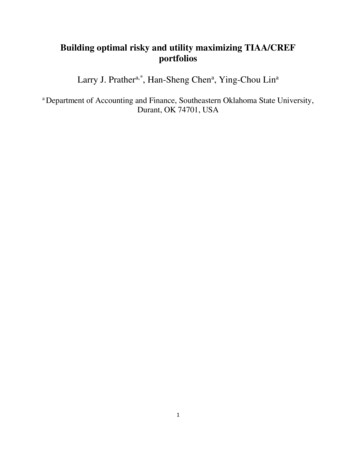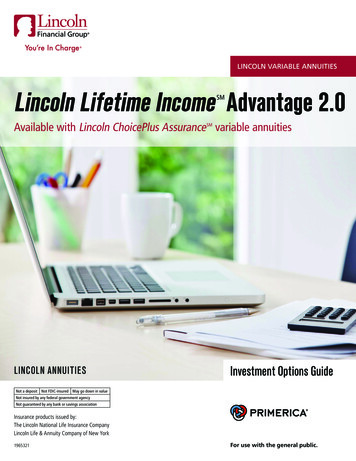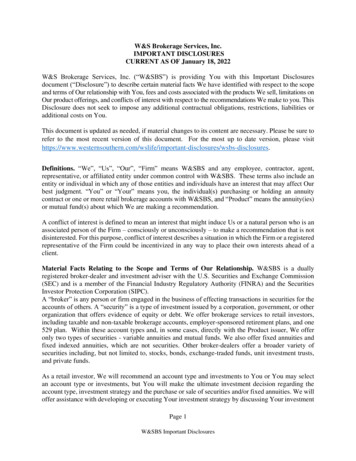
Transcription
THEECONOMICROLE OFANNUITIESRESEARCHCONDUCTED BY:MICHAEL J. BOSKINStanford UniversityB. DOUGLASBERNHEIMStanford UniversityPATRICK J. BAYERStanford UniversityA CATALYST INSTITUTERESEARCH PROJECTMARCH 1998 1998 Catalyst Institute, Michael J.Boskin, B. Douglas Bernehim, andPatrick J. Bayer. All Rights Reserved.
Catalyst Institute 33 North LaSalle StreetSuite 1920 Chicago, IL 60602 USA Telephone/ 1 312 541 5400 Facsimile/ 1 312 541 5401 E-mail/ Postmaster@CatalystInstitute.orgThe opinions expressed are those of the authorsand not necessarily those of Catalyst Institute.
CATALYST INSTITUTEiiiTABLE OF CONTENTSSUMMARYPAGE vSECTION 1/INTRODUCTION ANDOVERVIEWPAGE 1SECTION 2/UNDERSTANDINGANNUITIESPAGE 9SECTION 3/THE IMPORTANCE OFSAVING TO THEECONOMYPAGE 37SECTION 4/THE IMPORTANCE OFSAVING TO INDIVIDUALHOUSEHOLDSPAGE 55
ivSECTION 5/PUBLIC POLICIES TORAISE SAVINGPAGE 69FIGURES AND TABLESPAGE 93GLOSSARYPAGE 113REFERENCESPAGE 117ABOUT THE AUTHORSPAGE 129ABOUT CATALYSTINSTITUTEPAGE 131CATALYST INSTITUTE
CATALYST INSTITUTEvSUMMARYAnnuity contracts are unique saving vehicles that provide a framework for managingboth the accumulation and the payout phases of an investment. In their simplest form,annuities guarantee, in exchange for an initial capital payment, a periodic payout forthe remainder of an annuity owner’s life.Under current law, all annuity contracts— both qualified and nonqualified— allow theinvestor to defer taxes on earnings credited under the contract. Qualified annuities(e.g., annuity contracts purchased through a 401(k) or 403(b) pension plan or anindividual retirement account) also allow the deferral of income taxes on principalinvested in the annuity. Consequently, investments through annuities generallyprovide higher after-tax rates of return than do investments made outside of annuities.Sales of qualified and nonqualified annuity contracts have grown rapidly over the past10 years, outpacing the sales growth of other financial products such as mutual fundsand life insurance. This trend is largely attributable to provisions that allow earningswithin an annuity account to accumulate tax-free. Thus, the elimination of these taxprovisions would be expected to lead to a significant decrease in the demand forannuities and a corresponding decline in the nation’s saving rate.A decline in the United States’ saving rate is highly undesirable— especially at thistime. U.S. households currently save relatively little, by both historical andinternational standards. The net national saving rate in the United States has fallenfrom an historical average of more than 9 percent of gross domestic product in the1960s and 1970s to an average of less than 5 percent in the 1980s and 1990s. Thissubstantial decline in the saving rate has made the financing of investment moredifficult and has contributed to reductions in the growth of productivity, wages, andhousehold income in the United States.The importance of saving and of maintaining an environment that supports a widevariety of market-driven saving and insurance vehicles will grow in the years ahead,due largely to increases in life expectancy. The fastest-growing segment of thepopulation will be the elderly and, among them, the very old.
viThe economic implications of this transition will be far-reaching. The two largestgovernment programs that provide for the elderly, social security and medicarehospital insurance, have serious long-run actuarial problems, with projected benefitsexceeding projected receipts by trillions of dollars. Unless changes are made in theseprograms soon, the tax increases and/or benefit cuts necessary to bring these systemsinto balance will be wrenching.A major contributor to the low saving rate in the United States is the present taxsystem, which favors current consumption and debt at the expense of saving.Therefore, efforts to reverse the historical decline in saving must include governmentpolicies designed to encourage increased retirement savings. Annuities provide aparticularly appropriate focus for such policies.Policymakers should consider more tax incentives to encourage savings. Certainly,opportunities for tax deferral through annuities should be continued, as theirelimination would fly in the face of efforts to stimulate saving. Tax-deferred annuitiesprovide investors with powerful incentives to save.CATALYST INSTITUTE
THEECONOMICROLE OFANNUITIES
CATALYST INSTITUTE1SECTION 1/ INTRODUCTION AND OVERVIEWHouseholds accumulate long-term savings through a variety of financial vehicles.Alternatives range from employer-provided pensions to direct purchase of corporateequities, to purchase of whole life insurance, and to putting money in the bank. Oneincreasingly important option is the purchase of annuities. These centuries-oldvehicles come in many forms. Generally, annuity contracts package a savings accountwith a mechanism for managing the rate at which resources are withdrawn oncedisbursements commence. This mechanism allows the individual to insure against therisk of outliving his or her resources, to guard against inadvertent overspending, andto provide a financial cushion for survivors in the event of premature death. Theimportance of annuities has grown through time, as trends toward early retirementand tremendous gains in the life expectancy of the elderly have lengthened the averageretirement period, raising the risks associated with premature depletion of financialresources.In recent years, annuity markets have grown rapidly. Premiums for annuities nowexceed life insurance premiums received by insurance companies. According to the1997 Life Insurance Fact Book, 32 million Americans have individual annuitycontracts, and 20 million are covered by group annuities as part of their employerbased pension plans. These figures include qualified and nonqualified annuities. Themost widely used types of annuities allow accumulation of assets (inside buildup) ona tax-deferred basis, an advantage shared by several other long-term retirement savingvehicles, such as individual retirement accounts (IRAs), employer-provided pensions,and employee-driven pensions such as 401(k) and 403(b) plans.1 Section 401(k) and403(b) plans, of course, often make use of annuities as the preferred investmentvehicle. Thus, annuities are increasingly important in household decisions regardingprivate saving and investment.1This advantage is also shared by many capital assets, such as real estate and individual shares ofstock, since taxes are paid on capital gains only at the time of realization. However, annuities andthe other long-term retirement saving plans mentioned in the text are more flexible than these othercapital assets because they allow the investor to adjust the underlying investment portfolio withoutincurring tax liabilities.
2CATALYST INSTITUTEThe deferral of taxes on annuity income is justified by widespread concern over theadequacy of saving. As Figure 1.1 indicates, the net national saving rate in the UnitedStates has fallen dramatically from historic averages ofover 10 percent of gross domestic product in the1960s to a rate of just over 4 percent in the 1990s.The netNational saving is the sum of what households,U.S. saving ratebusinesses, and all levels of government save or, in thehas fallencase of borrowing, dissave. The overall saving ratedramatically from can, therefore, be decomposed into separate savingfor each of these categories. This decompositionhistoric averages ratesis shown in Figure 1.2. The decline in the net nationalof over 10 percent saving rate from 10.7 to 4.1 percent of gross domesticproduct from the 1960s to the 1990s can be attributedof GDP in theof1960s to a rate of to a reduction in each of the major components2saving— personal, corporate, and government.just over 4 percentin the 1990sSaving is critical to the health of the U.S. economybecause it is the primary source of the funds thatbusiness enterprises use to finance domesticinvestment. New investments are necessary to equip workers with productivityenhancing capital. A newer and larger capital stock allows each worker to be moreproductive and leads to both a greater growth rate for the economy and higher wagesfor those using this capital. Domestic investment can, of course, also be financed byimporting foreign capital, but experience demonstrates that inflows of foreign capitaldo not fully make up for low levels of domestic saving. Thus, the substantial declinein the saving rate has made the financing of investment much more difficult and has,no doubt, contributed to reductions in the growth of productivity, wages, andhousehold income. Inadequate rates of saving over the past 15 years have limitedgains in living standards for U.S. households, and continued weak saving poses aneven greater threat to the future prosperity of our nation.2The measures of saving and national product considered here are net of capital consumptionallowances for the depreciation of physical assets. This is appropriate, since depreciation amountsto negative saving.
CATALYST INSTITUTE3If domestic saving were to increase, U.S. interest rates would fall, and this wouldreduce the rate of foreign investment in the United States; however, total domesticinvestment would increase, bringing a variety of economic benefits. Numerousstudies demonstrate that a greater pace of capital formation leading to a larger andnewer capital stock per worker will increase productivity, which is the foundation forwage increases. Although other pillars of economic growth— sound money, newtechnology and ideas (which also must be financed), more and better-qualityeducation, improved resource allocation, and a myriad of other microeconomicphenomena— are important, the sizable effect of capital formation on economicgrowth is the most thoroughly documented.The potential benefits of increases in economic growth are enormous. A sustainedGDP growth rate of 2.2 percent (as currently projected by the Congressional BudgetOffice) would increase the size of the U.S. economy by 129 percent between 1998and 2035. A GDP growth rate of 3.2 percent would expand the economy by over230 percent over this same time period. Thus, a 1 percentage point increase in thegrowth rate (3.2 percent versus 2.2 percent) would increase the size of the U.S.economy in 2035 by an amount roughly equal to current GDP! Even half apercentage point increase in the growth rate, compounded over a generation, canmake the difference between a society that views itself as successful and one thatviews itself as feeble.Just as adequate saving is essential for healthy macroeconomic performance, it is alsocritical to the economic well-being of individuals and families. Saving is the methodby which households can reallocate resources over time and across uncertaincontingencies. Households often save to finance consumption during retirement orto pay for large, infrequent expenditures such as a down payment on a home or achild’s education. Saving is also a type of insurance, as it provides a financial reserveagainst adverse developments. This “precautionary” saving complements traditionalforms of insurance that protect against a variety of contingencies, from illness totemporary labor market dislocations. Yet most Americans currently save far too littleto ensure income adequacy during retirement or to weather adverse developmentswithout considerable financial distress.
4Despite the obvious importance of saving to thelong-run growth of the economy and to theThe existingeconomic well-being of individuals and families, theexisting tax system favors current consumption andtax systemdebt at the expense of saving. Taxes on nominalfavors currentcapital gains and interest income drive a wedgeconsumption and between the cost of capital paid by those usingsaving to finance new investment and the after-taxdebt at theof return that the saver receives. For anexpense of saving rateindividual making consumption decisions over a longtime horizon, these taxes on saving, and thus futureconsumption, distort the individual’s decisions, making present consumption moreattractive than it would otherwise be. Saving vehicles such as annuities, which allowthe accumulation of assets on a tax-deferred basis, help ameliorate this distortion.The importance of saving, and of maintaining an environment that supports a widevariety of market-driven saving and insurance vehicles, will grow in the years ahead.Figure 1.3 shows the historic and projected future trends in the life expectancy of a65-year-old woman. In 1940, the average 65-year-old woman was expected to liveapproximately another 13.5 years to the age of 78. By 1995, the corresponding lifeexpectancy had risen to the age of 84— a gain of more than a month in life span foreach calendar year. By 2070, according to the high projections of the Social SecurityAdministration, a 65-year-old woman could expect to live past the age of 90, almosttwice the additional number of years as the average 65-year-old woman in 1940. Inthe years ahead, the fastest-growing segments of the population will be the elderly—most of whom will not be in the workforce— and, among the elderly, the very old.These changes will have a dramatic effect on the ratio of the retired population to theworking-age population, as shown in Figure 1.4. Although the nation has been onsomething of a demographic holiday, with the elderly dependency ratio increasingonly slightly since 1980, in a few years this ratio will start to rise inexorably. By 2030this ratio will stand at approximately 36 percent, almost double the current ratio.Under the intermediate assumptions of the Social Security Administration, the UnitedCATALYST INSTITUTE
CATALYST INSTITUTE5States will go from one retiree for every 3.3 workers to one retiree for every 2.1workers.The economic implications of this demographic transition will be far-reaching. Figures1.5 and 1.6 show financial projections for the two largest government programs thatprovide for the needs of the elderly. Both programs have serious long-run (in the caseof hospital insurance, also short-run) actuarial problems. Projected benefits exceedprojected receipts by trillions of dollars, and unless changes in these programs aremade soon, the tax increases and/or benefit cuts necessary to bring these systems intobalance will be wrenching. Table 1.1 shows the projections of the CongressionalBudget Office (as of March 1997) for the federalbudget deficit if fundamental changes are not made tothe social security and medicare systems. AlthoughSocial securitydeficits are projected to be only 2 percent of grossand medicaredomestic product through 2005, they are expected torise dramatically as the baby boom generation retires. hospital insuranceThe projections for 2035 range from 10 to 28 percenthave seriousof GDP, depending on the economic assumptions usedlong-runby the Congressional Budget Office. In light of theseactuarialprojections, even greater urgency attaches to the taskproblemsof raising private saving, since this would reduce thepressure on the social security and medicare programsas well as on the federal budget deficit.In short, the United States stands at the threshold of the most stunning demographicchange in its history. Increased retirement saving and more-rapid economic growthare plainly required if adequate support is to be provided for the growing populationof elderly and retired individuals.To some extent, it is possible to raise the rate of national saving by reducinggovernment budget deficits. However, budgetary policy alone will not suffice; stepsmust be taken to reverse the historical decline in private saving. The relationshipbetween private saving and the budget deficit is important because some proposals to
6CATALYST INSTITUTEreduce the deficit would also reduce private saving; indeed, this is exactly whatoccurred in the 1990 and 1993 budget accords that limited contributions to taxdeferred savings accounts, as well as in the 1993 tax rate increases. Raising thenation’s saving rate requires us to reduce the budget deficit in ways that do not harmprivate saving and/or to raise the private saving rate in ways that do not worsen thebudget deficit.Because of their unique characteristics, annuities provide a particularly appropriatefocus for policies to encourage saving and promote retirement income security.Surprisingly, however, annuities do not appear to be well understood by the generalpublic or some policymakers. Indeed, episodic proposals to limit the amount, oreliminate the tax deferral, of annuities fly in the face of the obvious importance ofraising the saving rate and encouraging annuitization. The purpose of this study is toprovide an accessible explanation of the economic role, both current and prospective,of annuities.Toward this end, Section 2 describes the various types of annuities. It explains howthey work and the needs they address. It also documents the growing importance ofannuities as vehicles for saving and insurance, and explores the explanations for thisgrowth. Section 3 elaborates on the macroeconomic importance of saving, and placescurrent rates of saving in both historical andinternational contexts. Section 4 discusses theIt is importantimportance of saving to individual households,focusing on the adequacy of retirement saving and theto retain theof the demographic transition. Section 5tax-deferred status effectsconcludes with policy issues and options. Strategies toof annuities and raise both public and private saving are considered.The provision of economic incentives through taxto avoid thedeferred annuities is compared with other methods ofimposition ofencouraging private saving.limits on annuitycontributionsAs a general matter, then, it is important to retain thetax-deferred status of annuities and to avoid the
CATALYST INSTITUTE7imposition of limits on annuity contributions. Public policy toward saving in general,and annuities in particular, should make providing for their own financial needs aseasy as possible for future retirees.
CATALYST INSTITUTE9SECTION 2/ UNDERSTANDING ANNUITIESTo develop a comprehensive financial plan for retirement, an individual must addresstwo separate (but highly interrelated) types of questions. Questions of the first typefocus on decisions taken prior to retirement, in the accumulation phase: How muchmust I save each year to accumulate an adequate nest egg by the time I retire? Howshould I invest my savings? Questions of the second type concern decisions takenafter retirement, in the liquidation phase: Should I conserve my principal and live offcapital income, or should I sell assets to finance my living expenses? Should I planto downsize my house? What should I allocate to my heirs?Financial institutions provide a broad array of products and services designed tofacilitate this difficult planning process. Numerous vehicles for long-term saving,ranging from bonds to mutual funds to life insurance policies, compete for theattention and resources of the typical household investor. Annuities are unique withinthis broad class of saving vehicles in that most competing products focus onaccumulation and provide no framework for managing liquidation. In contrast, thestructure of annuities contemplates both of the retirement planning problem’s phases:accumulation and liquidation.This section traces the recent growth of annuity markets, elaborates on the distinctiveeconomic role served by annuities, and explores the factors that have contributed totheir growth, including tax provisions. Describing annuity contracts in somewhatgreater detail is useful before delving into these subjects.TYPES OF ANNUITIESAnnuity contracts can differ substantially with respect to the manner in which assetsare acquired and benefits are paid out. Some of these differences result from the legalrules that govern eligibility for tax deductibility of contributions. Most of thedifferences in contractual forms, however, simply reflect the range of optionsdemanded by annuity owners for managing both the accumulation and liquidationphases of an annuity contract. In this section, annuities are classified along severalimportant dimensions. These are summarized in Table 2.1.
10Ownership and ControlAnnuities can be either group or individual contracts. This distinction reflects thelegal status of ownership and control (whether the individual for whom the annuityis purchased legally controls the annuity) and is not specifically related to either theaccumulation or liquidation phases of the contract. Group annuities are purchased fora group of individuals by a third party, usually an employer. In this case, the employerretains the rights to control future investments into the annuity and to terminate theannuity contract. Group annuities are often an integral part of employer-provideddefined benefit pension plans, but they are also used in defined contribution plans,such as 401(k) or 403(b) plans, when employers wish to retain some control.Individual annuities, on the other hand, consist of all annuity contracts where therights of ownership and control of the contract remain with the individual whopurchases the annuity. These include annuities held outside of pension plans, as wellas many investments made within employee-driven defined contribution pension plans.Accumulation PhaseAnnuities provide investors with a number of options during the accumulation phase.One important dimension of flexibility concerns the timing of contributions. Singlepremium annuities are purchased through a single payment to the insurer. Periodicpremium annuities are typically characterized by a longer accumulation phase, duringwhich periodic payments are made to the annuity provider. Annuities with periodicpremiums are commonly used in the context of 401(k), 403(b), and other pensionplans (although, in some cases, participants have the option of instead purchasingsingle-premium annuities upon retirement). In most cases, the periodic payments areflexible and are often withheld directly from an individual’s paycheck.In the case of periodic-premium annuities, the payouts from the insurer to theannuitant are almost always deferred. That is, the liquidation phase of the annuity isnot scheduled to begin until some time in the future, naturally after the periodicpremiums end. In general, single-premium annuities can be either immediate ordeferred. On the one hand, a single-premium annuity may be purchased at the timeof retirement by an individual who wants to transfer retirement savings into an annuityto insure against the possibility of outliving his or her assets. Since this annuity isCATALYST INSTITUTE
CATALYST INSTITUTE11purchased just as retirement is beginning, payouts often begin immediately. On theother hand, a 35-year-old individual who wishes to take advantage of the variousfeatures that annuities offer, including tax deferral, might purchase a single-premiumannuity and defer the payouts until he or she retires 30 years later. Thus, in general,a periodic-premium annuity will be deferred, and a single-premium annuity can bedeferred or immediate.In an annuity’s accumulation phase, account balances can be invested in a variety ofways. A fixed annuity provides a guaranteed, contractually specified return onaccount balances; a variable annuity provides variable returns as determined byinvestment performance. Through variable annuities, the investor has considerableflexibility to customize an investment portfolio. For example, a variable annuitycontract might offer a choice of mutual funds, and the individual would then receivea return on account balances based on the performance of his or her chosen funds.The underlying investment opportunities actually offered through variable annuitiesare extremely varied. As will be discussed in the next section, a variable annuitycontract can continue to earn income based on an underlying investment portfolioduring the liquidation phase of the annuity contract.Some annuities combine the features of variable and fixed instruments. An exampleis the equity indexed annuity (EIA). Developed in the last couple of years, an EIAprovides some participation (usually not full) in equity markets while limitingdownside risk. An EIA typically guarantees a minimum rate of interest and thencredits excess interest based on an outside index such as the S&P 500. The amountcredited depends upon the performance of the index, the period over which theperformance is measured, and the participation percentage (the percentage of theindex credited to the EIA).All capital income accumulated within an annuity contract owned by individuals(inside buildup) is free from immediate taxation. Instead, taxes are paid at the timethese earnings are withdrawn during the liquidation phase. Although all annuitycontracts allow the deferral of taxes on accumulated capital income, qualifiedannuities also allow the additional deferral of income taxes on the money used to
12All annuitycontracts allowthe deferral oftaxes onaccumulatedcapital income,qualifiedannuities alsoallow theadditional deferralof income taxesCATALYST INSTITUTEpurchase the annuity.Qualified annuities arepurchased through a retirement plan, such asemployee-driven 401(k) and 403(b) pension plans andindividual retirement accounts (IRAs).Groupannuities purchased by an employer for a definedbenefit pension plan are also generally qualified.Nonqualified annuities are not purchased through aqualified pension plan and do not allow the deferral ofincome taxes on the initial purchase price. Instead,investors pay their annuity premiums with after-taxdollars. A more detailed discussion of the taxtreatment of annuities appears later in this section.Annuities purchased through qualified pension plans(e.g., 401(k) plans, 403(b) plans, and IRAs) offer ahigher after-tax rate of return than do comparablenonqualified annuities. However, yearly contributionsto these qualified contracts are subject to an upperlimit; the amount that can be saved through nonqualified annuity contracts has no suchlimit. Thus nonqualified annuities can be valuable to individuals who wish to save alarge amount quickly, even if they have access to qualified pension plans. Inparticular, nonqualified annuities can be an attractive saving vehicle for individualswho did not save sufficiently early in their working lives and need to save a largeamount just prior to retirement. As will be discussed later, many members of the babyboom generation may soon find themselves in this situation.Nonqualified annuities are also useful for those who receive large sums of money,perhaps from the proceeds of a life insurance policy or the sale of a home, farm, orbusiness. According to the most recent Gallup (1997) Survey of Owners ofNonqualified Annuity Contracts, 51 percent of owners used money from one-timeevents to purchase their annuities.
CATALYST INSTITUTE13Since annuity contracts offer a range of options for managing capital accumulation aswell as the deferral of taxes, they can be attractive saving vehicles even for individualswho have no interest in contractual options for managing payouts during the annuity’sliquidation phase.Liquidation PhaseAnnuities provide investors with a variety of options for managing distributions duringthe liquidation phase. Most annuity contracts, called income annuities, convertaccumulated assets or a single premium into streams of income. Of course, an ownermay decide to surrender his or her contract before the stream of income begins and,in doing so, receive the entire value of the annuity contract in a single payment. Anannuity contract might be surrendered by an investor who concludes that he or she nolonger needs or wants a stream of income.The simplest form of an income annuity is a life annuity, which provides a regularpayment for the life of the annuitant. The size of the periodic (typically monthly)benefit paid by a life annuity is based primarily on the life expectancy of the annuitant.For example, in 1995, for an initial 100,000 investment, a 65-year-old man wouldhave received monthly payments of approximately 794.3 This payment is based onthe life expectancy of a 65-year-old man as well as on other economic factors such asinterest rates. A younger man or a woman of the same age would have receivedsmaller payments for the same initial investment, owing to a greater life expectancy.Specifically, a 55-year-old man would have received 664, and a 65-year-old womanwould have received 717.The simple life annuity can be modified in two ways that allow for the possibility offurther payments upon the death of the annuitant. Naturally, such modifications affectthe size of the periodic income stream generated from any given annuity investment.3The payout data for the examples in this paragraph are derived from the July 1995 edition of Best'sReview. The payments are averages across all insurance companies, as calculated in Mitchell,Poterba, and Warshawsky (1997).
14CATALYST INSTITUTEGuaranteed annuities pay income for either the life of the annuity owner or a fixednumber of years, whichever comes last.4 Through the use of such contracts,individuals can guard against the possibility that they might die soon after theinception of benefits, before they have recouped a significant fraction of theircontributions. The guarantee is valuable to individuals who wish to provide resourcesfor heirs or survivors but offers no benefit to those concerned solely with providingthemselves with retirement income.Guarantees come at the cost of smaller monthly payments. The size of the reductionin monthly payments depends, of course, on the probability that the annuitant will diebefore the guarantee period is over. A young annuitant, less likely to die before theguarantee period is over, can purchase the guarantee at a lower incremental cost (interms of forgone monthly income)
Qualified annuities (e.g., annuity contracts purchased through a 401(k) or 403(b) pension plan or an individual retirement account) also allow the deferral of income taxes on principal invested in the annuity. Consequently, investments through annuities generally provide higher after-tax rates of return than do investments made outside of .










